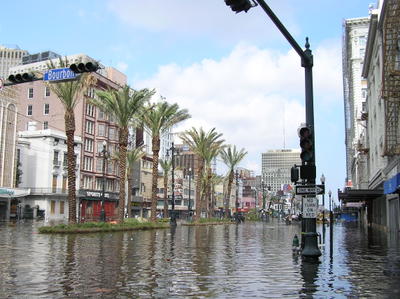We interrupt our holiday celebrations to remember that a year ago today the world was shocked by news of the greatest natural disaster in modern history—the
Southeast Asia Tsunami.
The 2004 Indian Ocean earthquake, known by the scientific community as the Sumatra-Andaman earthquake, was an undersea earthquake that occurred at 00:58:53 UTC (07:58:53 local time) on December 26, 2004. Here, in North America, most of us were still having a Merry Christmas at the time.
The earthquake originated in the Indian Ocean off the western coast of northern Sumatra, Indonesia. The resulting tsunami devastated the shores of Indonesia, Sri Lanka, South India, Thailand and other countries with waves up to 30 m (100 ft). It caused serious damage and deaths as far as the east coast of Africa, with the furthest recorded death due to the tsunami occurring at Port Elizabeth in South Africa, 8,000 km (5,000 mi) away from the epicentre.
At least 216,000 people are thought to have died as a result of the tsunami, and the true final toll may never be known due to bodies having been swept out to sea, but current estimates use conservative methodologies. Relief agencies warned of the possibility of more deaths as a result of epidemics caused by poor sanitation, but the threat of starvation seems to have been largely averted. The plight of the many affected people and countries prompted widespread humanitarian response.
A year later, the effects of the tsunami are still apparent in the region, and
The South-East Asia Earthquake and Tsunami Blog has continued to focus attention of the world on the relief efforts.
Evelyn Rodrigues, who found herself caught in the tsunamis in Thailand, and had live-blogged her experiences thus bringing the pain and suffering closer to people all over the world, goes back on a Tsunami Anniversary Trek, and once more shares with her readers, a first-hand account of her trip. Worth a read for those interested in looking into the lives of people, their pain, and fears that still haunt them, one year after the terrible disaster.
In the aftermath of the disaster, scientists and governments, under the auspices of the UN, began working on an early warning system for the region. One year on from the tsunami, the
BBC reports on what is planned and what is already in place with the Deep-ocean Assessment and Reporting of Tsunami (Dart) system.
But in North America, most people's attention has turned to this year's hurricanes, Katrina and Rita, that ravaged the U.S. gulf coast. When asked about the tsunami, many Americans might ask, "Was that last Christmas?"
What's for Americans to be concerned about? We're safely across an international date line and a world away from tsunamis, right?
The California Seismic Safety Commission has just released a new report:
The Tsunami Threat To California Report (pdf). California isn't any better prepared for a tsunami than the Gulf Coast was for the hurricanes—probably less so.
The Report makes seven main findings:
1. tsunamis are a real and significant threat to life and property along the coast;
2. risks to our major ports are most significant given the concentration of jobs, imports/exports and the potential to affect the nation;
3. we're not educated about what to do in the event of a tsunami;
4. the warning system is inadequate;
5. building codes in areas potentially affected by tsunamis are insufficient;
6. federal mapping resources are underutilized by planners to coordinate an evacuation; and,
7. the Governor's Office of Emergency Planning has stepped up since the Southeast Asia Tsunami and the more recent tsunami warning for California on June 14 and has made efforts to get ready.
But more needs to be done. The report, available on the website of the
California Seismic Safety Commission, has detailed recommendations that call for more funding, better education, and more cross-jurisdictional cooperation among government entities.
On the eve of the anniversary of the Southeast Asia Tsunami, the White House released a plan Friday directing federal agencies to increase earthquake and volcano monitoring systems, deep ocean buoys and other high-tech means of alerting oceanside communities, according to a report by the
Associated Press.
Specifically, the plan written by the president's National Science and Technology Council directs federal agencies to:
•Develop risk assessments of the potential tsunami hazards for all U.S. coastal regions.
•Increase the number of tsunami buoys, tide gauge and seismic sensors feeding real-time data into computer models to improve tsunami forecasting and warning systems along Pacific, Atlantic, Caribbean and Gulf of Mexico coastlines.
•Give technical help to improve warning systems for tsunamis and other hazards in the Indian Ocean.
•Encourage communities to develop tsunami response plans, and to build and plan in ways that can reduce the impact of a future tsunami.
John Marburger, who directs the White House Office of Science and Technology Policy, said U.S.-led improvements in tsunami detection and warning since a year ago made people safer at home and work, and the new plan will further reduce risks to life and property. Congress appropriated $24 million in May for a better U.S. tsunami system.
An international tsunami expert, however, said more high-tech warning buoys won't make a difference unless more cities and towns prepare, so that people know where to seek shelter. He also urged more land-use planning to avoid building schools and hospitals near ocean shores.
With the time between the earthquake event and the tsunami reaching shores being measured in minutes or hours, compared to days and weeks in the case of hurricanes, it seems that planning ahead and preparedness are at least if not more important than warning systems.


